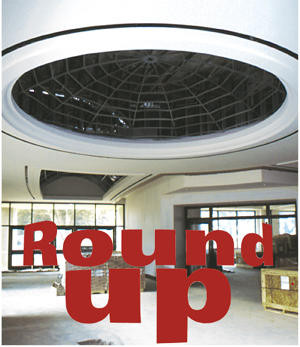
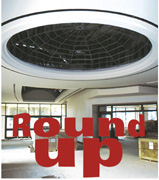
How advanced is it? Steven Capps, project manager and estimator for Acousti Engineering Co. of Florida Inc., the largest interiors contractor in the state, puts it this way: "There's stuff here that I have always wanted to do, but never had the opportunity to see if it was possible--and we did it."
The project is indeed breaking new ground both in design and construction methods for domes, curved barrel vaults and a huge saw-tooth suspended ceiling located in the main hall.
It's a project encompassing 215,000 total square feet of ceiling grid and 198 miles of steel wall studs, full of architectural sophistication and surprise. Interior spaces fan outward in the scallop-shell-shaped building, making right angles a rarity. In the 300,000-square-foot structure, only 12 90-degree corners exist.
"Not only is there a lot of barrel vaulting, but the barrel vaults are curving," says Manager Kenneth Nielsen of Acousti Engineering. "We had two compound actions going on at the same time in these ceilings."
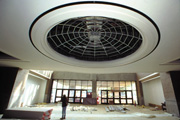
Tricky curves
The ceilings at Pensacola's Regent Auditorium are amazingly complex. So how did the contractor create these great-looking domes and compound radii? How did the firm keep costs in line? How, in short, did the curvy overhead work get done?Acousti Engineering had the $10-million contract to construct the walls and ceilings at the auditorium. Incorporated in 1946, the Pensacola firm employs more than 1,500 people and provides four core services: ceilings, floors, walls and specialty construction.
Acousti Engineering's presence at Regent Auditorium was extensive. Of the 30 to 40 interior-finish sections specified in the construction plans, the firm claimed 14 sections. It was responsible for all metal wall studs, gypsum board, ceiling grid, acoustical panels, sound reflectors, glass-fiber-reinforced gypsum moldings, EIFS and more.
Despite having broad responsibilities, Acousti Engineering's biggest challenge--and probably its most visible work--was the creation of 19 separate domed ceilings. Steven Capps, project manager and estimator, and Nielsen recommended specifying completed domes.
"We were able to bring product concepts to the architect," says Capps, who stepped in as project manager for the auditorium in May 1999. "That really goes to show you that we worked with a good owner, a good general contractor and a good architectural group."
Originally, the architect specified curved drywall ceilings and vaulted corridors, hoping the contractor could fabricate them using hat channel steel, black iron suspension and GRG ceiling shapes. But the design got reworked when USG developed a pre-engineered and prefabricated system for creating domed ceilings.
The USG dome application is part of a larger product family--USG's Drywall Suspension System. This system offers contractors a different way to install drop drywall ceilings, claiming to reduce the time spent measuring, bending, cutting and connecting radius components. The system suspends with 12-gauge hanger wire rather than 9-gauge wire.
USG is supporting its dome systems with an Internet-based design tool that enables contractors to create construction and material information on domes, vaults and other curved surface designs. The USG Drywall Suspension System Estimating Wizard can provide a complete bill of materials and installation instructions required to complete the specific project.
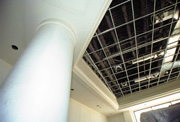
19 domes a-rollin'
USG provided turnkey engineering services for the Pensacola auditorium. Main tees, cross tees and crosspieces were designed and prefabricated in Ohio, and then packaged and shipped to Florida. Acousti's crews did the assembly.The domes add a refreshing touch to long hallways at Regent Auditorium. They punctuate the ceilings with architectural curiosity and provide circular backdrops for each of a series of large chandeliers that hang prominently overhead.
Nielsen says Acousti's ceiling crews have never worked with anything quite like USG's domes. The system provides architecturally true radii, and only one day and a two-man crew are needed to install them.
Capps estimates that the efficiency of the pre-engineered and prefabricated system shaved 72 man-hours off the installation of each of the 10 18-foot-diameter domes, and 37 man-hours off the installation of each of the nine 12-foot domes. According to Capps, it would have taken three crew members four to five days to fabricate similar domes from scratch.
"Of course, the first dome took a little extra time?--maybe an extra half day--to get the bugs worked out," says Capps. "It was worth it. I have never seen domes that look this good."
"It's a great system," adds George E. Hunter Jr., AIA, vice president of Strobel & Hunter Inc., in Pensacola. Hunter, who's been in the business since 1978, says Regent Auditorium was the first project on which he and partner Stan Strobel had ever specified these types of domes.
"The system lends itself to creating perfect domes," says Hunter. "It allows for real precision--perfect radii, perfect curves--as opposed to putting up metal studs, hat channels and furring channels that would have taken forever."
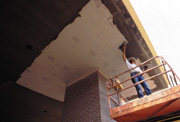
Fiberock sheathing with Aqua-Tough, which has been approved by USG for use with the Drywall Suspension System.
Valid points
But creating dome ceilings was only one aspect of the job. Regent Auditorium also features 2,100 lineal feet of barrel-vaulted ceilings--a run in just about every hallway.Here again, installation was easy because each barrel vault was pre-engineered and fabricated off site. USG accommodated the architectural drawings and manufactured custom curved main tees--since the vault radius was not a standard size--and that made Acousti's work easy.
"We didn't have to bend any of the barrel vault grid," says Nielsen. "The only challenge was getting the vaults leveled at the proper heights."
To tackle the challenge, Acousti purchased four lasers exclusively for the project. The company also brought in a professional surveyor to establish the radius points.
"The rest of the (contracting) subs worked from our points," says Nielsen. "They used our layout work as a guide for their trades."
Indeed, Acousti helped out the other trades by getting its work done quickly. Working with USG's Drywall Suspension System, a two-man crew was able to hang prefabricated main tees and snap in cross tees in four hours--instead of an estimated five days--by fabricating everything on site. The system calls for nothing more than "standard acoustical ceiling mechanics" to install, says Capps.
Once completed, the suspended barrel vaults were covered with special acoustical panels. Double cross tees were specified at points in the vaults where the panels connect--an engineering detail that helped Acousti Engineering crews snap panels in place and save time.
Skills at work
All the work was done with strict precision and following quality guidelines. The owners of the auditorium, for instance, wouldn't allow any gypsum board less than 5/8-inch thick. Where gypsum drywall covered a radius, Acousti Engineering used two layers of Sheetrock Brand Gypsum Panels--one 1/4-inch thick and another 3/8-inch thick to create a 5/8-inch thickness."We pride ourselves in having the Sheetrock panels blemish-free and seamless," says Nielsen. "But you can only accomplish that with great skill in finishing."
Actually, Regent Auditorium tested Acousti's skill over a broad range of products. Besides the dome and barrel vault ceilings, company crews installed Durock cement board on bathroom walls, having to make numerous cutouts for electrical boxes and plumbing. Tapers worked Sheetrock Brand Paper Faced Metal Corner Bead into various walls and soffits. Outside, the carports called for hangers to install Fiberock sheathing with Aqua-Tough, and finishers to top the panels with a direct-applied stucco-like coating.
If Acousti crews seemed to dominate the site, it's probably because they did. Some handled basic production work--piecing together metal tees, hanging 5/8-inch Sheetrock panels, Firecode Core Type X drywall in shaft walls and mixing Sheetrock All-Purpose Joint Compound, Midweight. Others contributed craftsmanship and precision--measuring, cutting and installing high-end Centricitee 9/16-inch ceiling grid in completely out-of-square rooms.
Regent Auditorium broke ground early in 1999, and Acousti Engineering began working on the job that spring. The company had a peak of 110 workers on site and finished its work in the summer of 2001.
Nielsen, who was born and raised in Pensacola, feels very much at home at Regent Auditorium. He's pleased with the appearance of the interior, and credits the success to his project manager, Capps, to his chief foreman, Donnie Holley, and to the vision and open-mindedness of the auditorium owners.
"We all had a good attitude out here," says Nielsen. "The owners don't ever skimp. They wanted a 100-year building--not something that will have to be remodeled in 10 years. If there's time to better a system on the project, they will do so. It's nice to have that freedom."
At one point, Capps watched his crews working on the saw-tooth ceilings in the main assembly hall. Each box of specially measured and cut cross tees had a numeric code indicating where it fit in the ceiling. Workers fastened the main tees and snapped in the cross tees, and the gypsum board soon floated along the crescent-shaped, saw-toothed ceiling.
"This is a custom job in every aspect," says Capps. "With USG's help, we've solved a lot of problems."
Nielsen, who worked his way up from a laborer to manager in 25 years, has seen it all, but Regent Auditorium is special. He wonders whether the architectural world will ever be the same.
"Who's going to want a rectangular ceiling," he asks, "when you can have a dome?"
